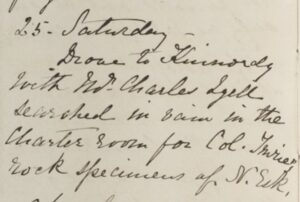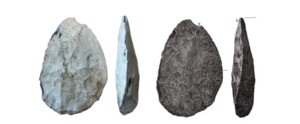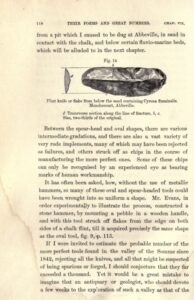Will Adams completed his MA Archaeology dissertation at the University of Edinburgh Summer 2023 looking at Lyell’s archaeological specimens – achieving an impressive 78% and winning an award to boot! Read on to find out more about his spectacular findings…

Scientific Notebook 266 page 14
Many specimens from Charles Lyell’s private collection were donated to the University of Edinburgh in 1927 and came directly from his family home and birthplace of Kinnordy House. In the very last Scientific Notebook, number 266, dated 17 July-23 November 1874, Lyell, in advancing age, is driven to Kinnordy to search “in vain in the Charter Room for Colonel Imrie rock specimens of N. Esk”.
This indicates that any finding aids to access what must have been a voluminous personal collection, even during Lyell’s lifetime, were problematic. No detailed documentation about the specimens at the time of the gift in 1927 appears to have survived, and the absolute authentication as having been part of Lyell’s specimen collection, is reliant on the existence of original labels. Subsequent use by staff of the University also had an impact on the specimens – a split occurred in the collection, with specimens now held by both the Cockburn Geological Museum and the Vere Gordon Childe Collection.
This paper is a study of the archaeological flint tool, VGC1363, held in the Vere Gordon Childe Collection and shows how it can be irrefutably reunited with Lyell through studying the object alongside his printed publications and recently acquired notebooks. This work highlights how an interdisciplinary approach utilising archive, library and museum evidence is essential for provenance research in scientific collections.

Figure 1. Illustration by Adams (2023) showing a match of specimen EUCM.0001.2022 with a figure in Lyell’s The Geological Evidences of the Antiquity of Man (1863) realised by Dr Gillian McCay, Curator of the Cockburn Geological Museum
Using Lyell’s books as source material, Gillian McCay, Curator of the Cockburn Museum had confirmed that specimen reference EUCM.0001.2022, in Figure 1, had been ‘figured’ and included as an illustration in Lyell’s last major work, The Geological Evidences of the Antiquity of Man (1863), which had huge public success with almost all of the 4000 copies sold in its first week of publication (Cohen, 1999, 90).
Looking at the rest of the collection, I was intrigued to find out if I could reveal any more, and was particularly interested in a set of flint hand axes in a draw labelled “Misc. French Flints” in the Vere Gordon Childe Collection, that have ‘Sir C Lyell’ written directly on them or on the object label.
VGC1363: An indication of Lyell
Collecting evidence was critical for Lyell – surely more specimens could be found and identified, using his books? From developments in the human antiquity debate by Joseph Prestwich and John Evans in 1859, Lyell conducted his own research in the Somme Valley to provide an authoritative judgement.

Figure 2. Page 118 Antiquity of Man
Figure 2 shows page 118 of Lyell’s Antiquity. Studying this page carefully and using my knowledge of archaeological illustration I could see that this flint tool displayed in Lyell’s “Fig 14” has been broken in half from the “b” and “c” line in the original illustration and the section shown at “d”. Out of all the miscellaneous French flints in this draw, I could now narrow down my search to broken flint tools to provide a positive match.

Figure 3. Photograph by Adams (2023) of a drawer in the Vere Gordon Childe Collection labelled as “…Misc. French Flints” with specimen VGC1363 highlighted by a red circle
The flint tool circled in Figure 3 is broken in half, making it a candidate. It is fortunate to retain its label which reads “Sir C. Lyell, Menchecourt bed – ‘e’, March 1861” this connects it to Lyell. The connection is further supported by Lyell’s description of “Fig.14” as being a flint knife from Menchecourt (Lyell, 1863, 118).

Figure 4(a): Illustration by Adams (2023) comparing VGC1363 with “Fig.14.” through correspondence points; and on the righthand side Figure 4(b): Illustration by Adams (2023) showing a match of the specimen of Cyrena (Corbicula) fluminalis, EUCM.0222.2023, from Erith, Kent to illustration “d” in “Fig.17” of …Antiquity of Man (1863)
Furthermore, the illustration in Figure 4(a) shows how the object matches morphologically to Lyell’s “Fig. 14.”, through the transverse section and from the front view of the object.
This is an important object because of its context of being found “below the sand containing Cyrena fluminalis, Menchecourt, Abbeville” (Lyell, 1863, 124). Later in the book, Lyell goes on to explain that Cyrena (Corbicula) fluminalis is now an extinct species of freshwater shell in modern Europe, suggesting that the presence of a human modified flint tool in a stratigraphic layer below this shell supports human antiquity (Lyell, 1863, 124).
In Figure 4(b) a specimen of Cyrena (Corbicula) fluminalis held in the Cockburn Geological Museum collection appears to match the illustration and place name description of “Erith, Kent” typed in the extant label, in illustration “d” in “Fig.17.” of Antiquity of Man (Lyell, 1863, 124).
Turning away from the source material of books, and object labels – I was also able to consult Lyell’s rich archive, including the 294 notebooks. Knowing the time frame, and location I was able to establish that Lyell’s Notebook 245 records him being on site in Menchecourt in March 1861.

Figure 5. Figure 5: Edited photograph taken by Adams (2023) of Lyell’s notebook showing the flint knives place in the stratigraphy with a photograph of VGC1363 superimposed into the stratigraphy.
Figure 5 shows an edited version of Lyell’s stratigraphic drawing during his time there, showing flint knives found below a layer containing Cyrena (Corbicula) fluminalis. Lyell’s note at the top of the page 138 reads “Menchecourt. Two specimen of knives found below a marine bed with cyrena” which is the conclusive proof placing Lyell at the right place and time to uncover VGC1363.

Figure 6. Figure 6 The six archaeological specimens from University of Edinburgh conclusively connected to Charles Lyell. From top left to bottom right: EUCM.0001.2022; VGC1363; VGC1368; EUCM.0311.2009; VGC0860; VGC1366 (Adams, 2023)
Lyell’s specimens confirmed
Through my 4th year MA Archaeology dissertation, I conclusively identified another five archaeological specimens in the University of Edinburgh’s collections, shown in Figure 6, as belonging to Charles Lyell, and, through archival research, was able to create detailed object biographies for each. Although there are more flint hand axes with Lyell’s name attached which have not yet received the same detailed analysis, the trends seen in the object labelling system of the six specimens are consistent with the others in the collection. This makes it highly likely that the ‘Sir C Lyell’ labelled hand-axes in the Cockburn and Vere Gordon Childe collections belonged to the private collection of Lyell. An interdisciplinary approach was essential for determining the provenance of all six of these specimens – I had to apply both my archaeological knowledge and skills as well as newly acquired archival skills such as palaeography to fully understand what I was seeing. Piecing together this information was further complicated, due to a lack of relationships created between the different collections. As I embark on my working career, I’ll definitely advocate for establishing relationships between archive, museum and library catalogue entries to avoid a loss of provenance and the dispersal of materials.
Thank you, Will, for all your efforts – you should take great satisfaction for your part in identifying and repatriating a set of ‘miscellaneous French flints’ as being crucial to Lyell and his role in the Antiquity of Man debate, from which all future users will benefit!
Further reading
Cohen, C. 1998. Charles Lyell and the evidences of the antiquity of man. Geological Society Publications 143, pp. 83-93.
Lyell, C. 1863. The Geological Evidence for the Antiquity of Man (3rd Ed). London: John Murray.
